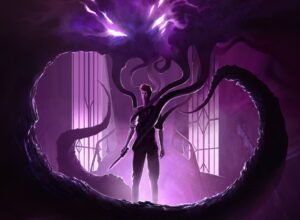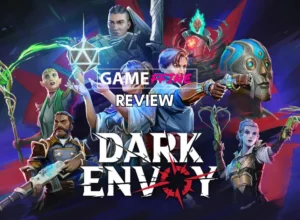Life simulators have been a rage ever since the pandemic began. With people being forced to stay indoors, a lot of people tried venturing out via video games and virtual reality. We projected ourselves onto the characters in the virtual worlds, exploring them to our heart’s content as a deadly virus raged on the streets outside our homes. Animal Crossing: New Horizons was an AAA title from Nintendo that allowed the genre to truly shine. However, being a Switch exclusive, it was still pretty restrictive by nature. Things really started going when games like My Time At Portia and Stardew Valley blew up. While they might not have the touch of a large publisher, they certainly have a certain degree of polish that is comparable to that of AAA titles. My Time At Portia was so successful that the devs decided to continue building on the universe and expanded to another region in the same universe. My Time At Sandrock continues from where My Time At Portia left off (though if you are entering Sandrock first – you really won’t be missing much expect bits and pieces of lore).
My Time At Sandrock is a standalone indie life simulator (or a sandbox crafting simulator) developed and published by Pathea Games. The game was released on May 26, 2022 in Early Access, and is currently available on Steam and the Epic Games Store for the PC.

Same Universe, Different Setting
My Time at Sandrock is set in the same universe as My Time at Portia. The world had experienced cataclysmic destruction, forcing humankind to rebuild from scratch. Most humans scrambled to build small settlements and live on with primitive tools. Gradually, as time went on, people evolved the tools they had with the help of the tools humanity used before the collapse of civilization. Going into the ruins of the old world remains of old-world tools were used to mechanize and improve the efficiency with which work was done. Of course, not everyone is good-natured to use the power of old-world technology for the benefit of anyone who was left behind by the apocalypse. The Duvos Empire, a warmongering nation in the post-apolcayptic period comparable to the likes of the Fire Nation from The Last Airbender or Noxus from League of Legends, wants to rule over every human alive. This led to the formation of the Free Cities – a bunch of cities for trade and commerce and where people can live away from the war started by the Duvos Empire. Both Portia and Sandrock are members of the Free Cities bounded by trade, commerce, and an agreement to help the other members in need when required.
Both My Time At Portia and My Time At Sandrock start with the protagonist arriving in the city and taking up the post of a Builder. Builders built everything the city’s residents need. – ranging from simple stuff like boxes, glass panels and copper pipes to gigantic machines, cranes and pulleys. However, there’s a small difference in the contributions the Builders make to keep the city afloat. Portia is a well-established city close to a river and old-world ruins – the landscape is also lush-green, allowing for crops to be grown and livestock to be reared liberally. Sandrock, in comparison, is more of a small town in the middle of the desert. There’s only an oasis from where the residents draw water, and cutting down trees is an activity that can get you fined. However, this also means that your actions have a way of changing the fate of the town. This is a pretty neat feature that allows you to learn about “sustainable development” (something our political leaders still can’t wrap their heads around) and how to ensure it is done without bringing down the whole town.
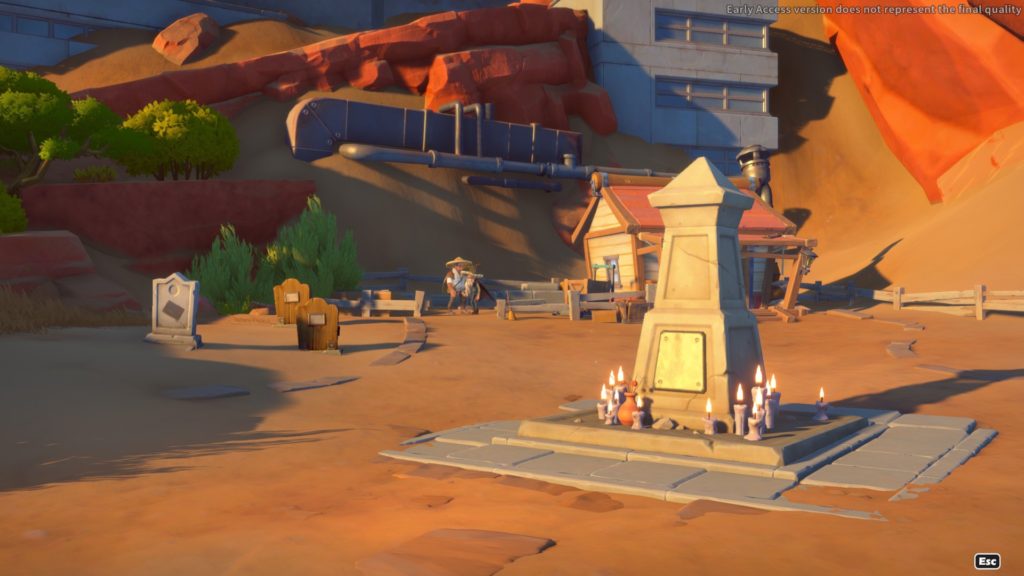
Despite being a small town, Sandrock’s residents have a lot of value to offer to the Builder. You have shops selling supplies, tools, raw resources, and even finished goods. There also are shops that offer you services in exchange for Gols (the currency that post-apocalyptic humans use) – like bringing up designs of better tools, teaching you how to cultivate crops or practice irrigation, or even allowing you to play arcade games (to name a few). The town might be situated in the middle of nowhere, but it doesn’t stop the residents from meeting and greeting the Builders whenever they pass by. The best part about the residents is how unique every NPC is – you get to remember them by name as you go about doing your chores in the world.
My Time At Portia was only playable in single-player. My Time At Sandrock, however, allows co-op multiplayer. In co-op, players can distribute workloads among themselves to ensure they do commissions and progress the story all at once. There’s just one big drawback though – the multiplayer option is being actively built by the talented team at Pathea Games, and there will be some time before it is shipped to the game. For now, I’m afraid players will have to be restricted to the single-player mode.

The Exciting Life of a Builder…..Not
The job of a Builder is pretty simple – build whatever the town of Sandrock needs them to build. In order to do this, resources need to be harvested – they need to be processed and used to construct finished goods. You need to construct better machines and upgrade them, later on, to produce more varieties of goods and process raw resources faster. The faster resources are processed, the faster you can move up the corporate ladder and establish yourself as the best Workshop in Sandrock. The higher the rankings, the more “respect” you earn among the residents of Sandrock. Machines and devices need to be assembled on an open platform by placing the several components it needs on it in steps.
As a builder, you will be doing commissions given out by the various residents of Sandrock to earn reputation and Gols (money). The more difficult it is to assemble something for a commission, the more reputation, and money it rewards. Initially, only basic commissions are given which can be assembled using the workbench after some gathering. Later on, one needs to move on to cultivating crops and making more advanced goods as the competition among the workshops becomes more fierce. What felt really nice is how the progress made by the new Builders hired by the city of Sandrock can also be correlated with the growth of Sandrock itself. As Sandrock grows, more stuff gets unlocked and commissions also become more complicated. The number of commissions is kept quite large to ensure that a large number of Builders in the city get to do something to contribute to its growth. Resources also become more scarce, requiring you to head down to the depths of the old world ruins where traps and enemies abound.
The game’s gameplay loop seems familiar to something like Stardew Valley and Animal Crossing. Well, it does employ similar gameplay concepts – but there always are points of distinction that stand out in favor of My Time At Sandrock. The main theme of the game is the concept of sustainable development, a theme that keeps being iterated on multiple occasions. Also, there’s some deep-rooted lore in Sandrock and Portia that is not present in similar games – probably the reason why a sequel could be developed in the first place.
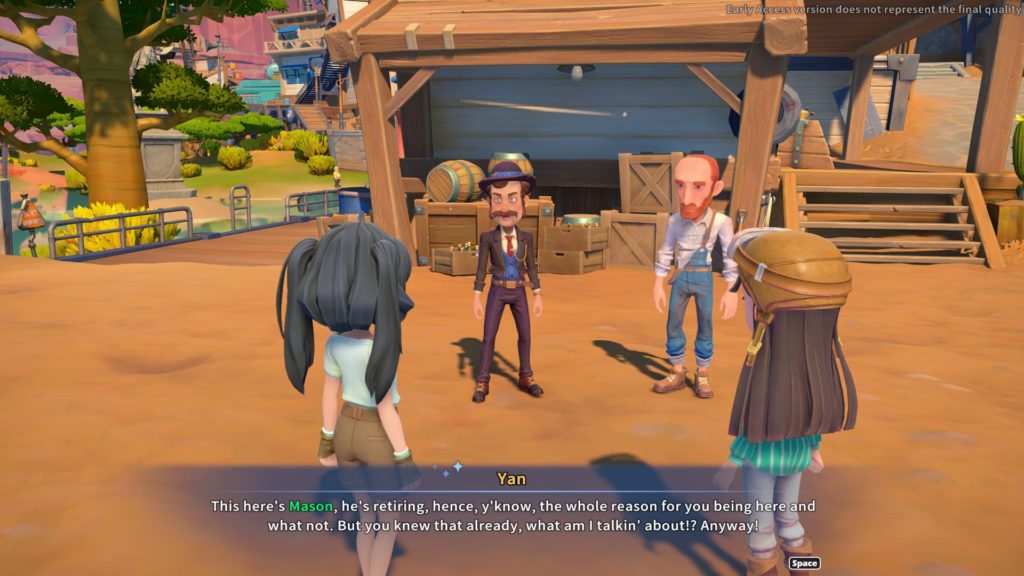
The game also has an intrinsic focus on NPC interactions. The more you talk with an NPC and gift them – the closer you become. Of course, at certain points of your relationship, the NPC might be so impressed that they offer you special discounts at their shop or some other benefits that may improve your workshop performance immensely. Naturally, it is always better to keep a watch on your relations. Doing commissions for them is one way of improving relations while talking and gifting stuff to them also helps improve relations. Each NPC has an aversion and likeness for particular stuff – the idea is to find out who likes what by random trial and error.
The best possible theme that the game presents is that in a desert town, all development should be done in a manner the environment is not affected. Water is a scarce resource that needs to be crafted or purchased from the town. In turn, all machines are powered by water as well as some power source. The stronger the power source (like old-world power cores), the more time it can keep the machines powered – but without water, all machines are sitting ducks. From the very beginning of the game, the Builder is warned from cutting down the trees in the region. If you still ignore the order, you are going to be fined and your relations with several NPCs might be affected. The main idea is to allow the Builder to find alternatives to building stuff wherever possible while keeping the environment in mind. This theme is probably why Sandrock is a game that hits a better home run than Portia when it comes to life simulator games on the PC.

A Beautiful Yet Depressing Landscape
My Time At Sandrock is made in a way that the environment truly resembles something that seems post-apocalyptic. A desert atmosphere is something that is also used in games like Fallout to indicate nuclear irradiation. The design of a desert town on the brink of destruction – kept alive by the Builders providing tools and materials to the community to survive has been nailed perfectly by Pathea Games. Sandrock is more heavily dependent on old-world technology as compared to Portia – an idea that keeps recurring in the game time and again (which can be explained by the fact that Portia does not face the same challenges that Sandrock does). NPC design mostly remained similar to Portia – slightly clunky, yet something that does not seem out of place. The animations are definitely a region where they stumble – the running, mining, attacking, and gathering animations look extra twitchy and do not really fit in.
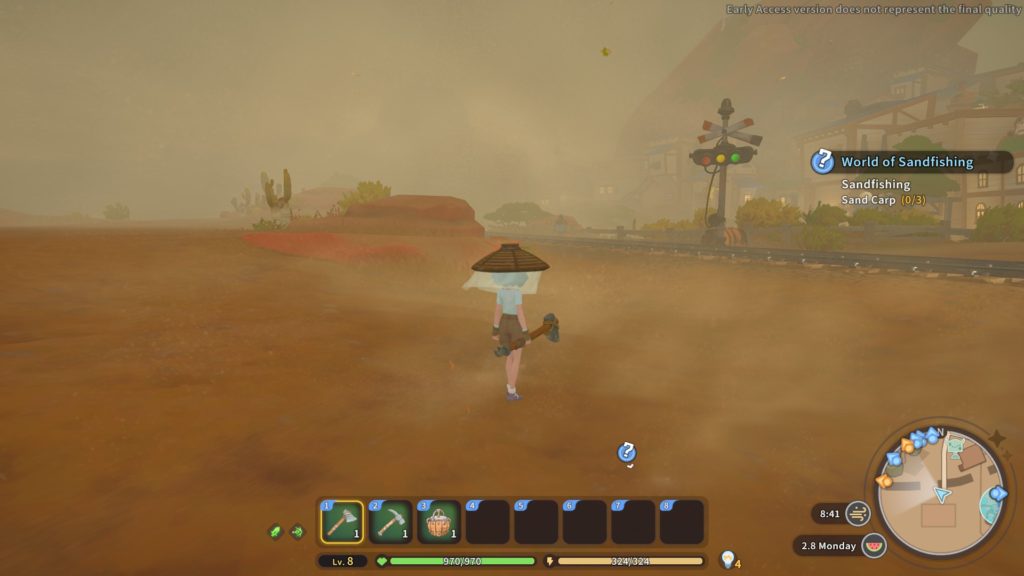
I did not face any major framerate issues with the game, which was surprising because My Time At Portia ran really horribly in the first few months of early access. I have experienced some random crashes, but that’s about it – it’s clear that the launch and patches for the first game have taught the development team a thing or two.

Simulating Life, the Post-Apocalyptic Way
My Time At Sandrock is a life-simulator that manages to get the soul of a post-apocalyptic world correct while staying cheerful for the most part. The game, even in its current state is indeed something that can be enjoyed by people of every age. If you’re a bit bored of the lack of game releases in the second quarter of this year and want to pick up something that you can play for a while – My Time At Sandrock should certainly be on your radar.
INITIAL RATING: RECOMMENDED




